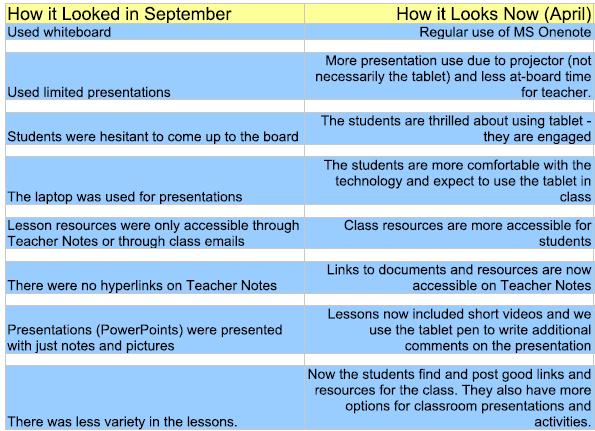7 Months Later - The One Computer Classroom

Cross-posted at ThumannResources.com
Most of my job for the Center at Rutgers is sustained professional development. I truly believe in this model as you can only learn so much in four hours or a day. You have to have time to think about it and implement it. Participants have to feel comfortable and willing to ask questions and try activities again.
One of the districts I began working with this year has decided to begin integrating technology into the curriculum by purchasing tablet PCs and projectors for their middle and high school math and science teachers. This is the first phase of a multi-year initiative that they have planned that slowly upgrades their level of technology literacy. We began the year talking about the One-Computer Classroom.
The HS teachers entered their comments in a public Google spreadsheet.

This first cohort of teachers are thrilled to have a laptop/tablet to use. It's the first piece of hardware they've had in years that they can rely on for productivity, classroom presentation and small group activities. We were allotted pretty much a meeting a month. Well, not even. We met five times over the last seven months and communicated via a Ning I set up for all the teachers enrolled in the program.
When we gathered for our final session, the teachers spoke of how thrilled the students were about using the tablet. It's still novel, even in April. Students don't have access to tablets in all classes as they're being rolled out over a couple of years, so they look forward to using it when they can.
Students also look forward to being engaged by the types of technologies and activities that we have reviewed and implemented this past seven months:
Tools and ideas to transform education. Sign up below.
- Google Apps (ie Forms, Google Docs, Google Presentations, Google Spreadsheets)
- Ning / Edmodo
- Wallwisher
- Wordle
- Voicethread
- Poll Everywhere
- Google Earth
- Drop.io
- Screencast-o-matic
Each session, we also reviewed specific content-related resources in biology, physics, chemistry, environmental science, math analysis, algebra, calculus and geometry.
The biology teacher, Steven Klass, even went as far as to create a private education (social) network for his students using Edmodo. He had requested some information early on in the year about how to create one safely and effectively and we had discussed some benefits of encouraging students to communicate about classroom content online. Using Edmodo, Mr. Klass up his AP Biology students to talk about content online. He also posted resources from class and it turns out, so did they. He was pleasantly surprised when, after a few weeks in Edmodo, students from his class started posting links to biology videos and articles for their classmates to read. He even wound up inviting a few students from another section in so that they could also benefit from the information.
I noted as we were scanning the chat that there was one student who was very vocal in the logs. I asked Mr. Klass if this happened to be a student who participated a lot in his physical class, and no surprise to many of you reading this post, this was a typically quiet student. It was a pleasure to listen as the teachers in the room spoke of how he participate online versus in the room and how the wheels churned a bit as to how this might benefit some of their students as well. Next year, Mr. Klass plans on opening the social network to the rest of his science students.
So, it's been all positive in my post up till now. I try to be open and honest and this time is no different than others. One teacher admitted that he just could not use technology as a resource for students to submit assignments. He was not having success with it this year. He would, however, set the expectation from the beginning next year with the families, and give it a try again in the fall.
Another teacher admitted that the technology does keep the students engaged, but she was unwilling to share the tablet with them, so the students really weren't benefiting from hands-on time. Yet, she's in the chart above transforming from verbal lecture only to sideshows with hyperlinks and videos. There is progress and the hope for more next year.
Are you in a school where the technology is not in the hands of the students? How do you go about getting it to them? Is it through homework or class time or some other way? Please share your experiences or suggestions.
